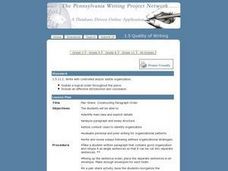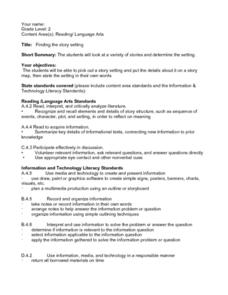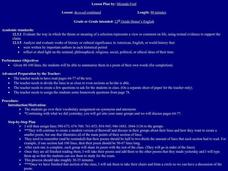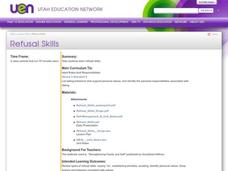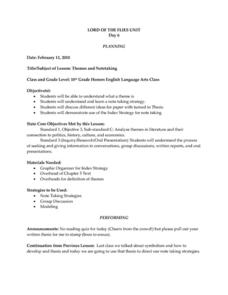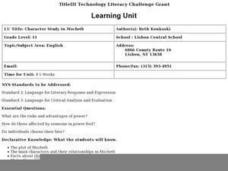Curated OER
Streamlines and Breadlines
Students explore the Great Depression. In this Great Depression instructional activity, students research selected websites and analyze primary sources to conduct inquiries regarding the depression, northern migration, and urbanization....
Curated OER
Identify and Evaluate Problem-Solving Processes and Solutions
Students identify a problem, the process by which it is solved, and the solution in a piece of literature. In this problem solving lesson, students read a nonfiction passage and use a think-pair-share strategy to identify the problem...
Curated OER
Pair-Share: Constructing Paragraph Order
Students write with controlled and/or subtle organization. They identify the main idea and explicit details. Students analyze paragraph and essay structure. They utilize context clues to identify organization.
Curated OER
Renaissance Realities
Students analyze passages by Niccolo Machiavelli and Francis Bacon as an analysis of Renaissance ideas in contemporary situations. In this Renaissance writings lesson, students read excerpts from Machiavelli's The Prince and multiple...
Curated OER
Origami
Students investigate Japanese culture by creating origami. In this Asian heritage lesson, students utilize the Internet to view origami tutorials which they use to create birds and other animals. Students discuss what "heritage" means...
Curated OER
Finding the Story Setting
Second graders discuss important things to know when reading stories, identify setting in variety of stories, create story map to record information as they are reading, state setting in their own words, discuss whether they thought...
Curated OER
The Human Jigsaw
Fourth graders, using Thomas Paine's "The Crisis, No. 1" from The American Crisis, form a human jigsaw.
Curated OER
Man in Conflict - Vietnam and Literature
Eleventh graders analyze the lyrics of protest music. In this Vietnam War lesson, 11th graders examine conflict as they consider the controversial nature of the war as evidenced in song lyrics. Students also consider the Iraq War and its...
Curated OER
Media Literacy Unit - Part 4
Seventh graders study how advertisers use techniques to sell their products. In this persuasive media lesson, 7th graders analyze media messages to find the advertiser's purpose. They examine different advertising techniques and their...
Curated OER
The Little Red Hen
Students analyze a classic children's story by discussing it with their peers. In this reading comprehension lesson, students read The Little Red Hen, and discuss ways the hen takes care of his responsibilities. Students utilize Clip...
Curated OER
Beowulf
Learners read selections from Beowulf and summarize the poetry selections in their own words. Students discuss the poem, then create a modern version of Beowulf by using their own words and their own poetic form.
Curated OER
The Art Of Persuasion
Students engage in a lesson that focuses upon the use of persuasive speech. They conduct research into the famous sayings used by sideshow owners and performers from the Old West. Students then create advertisements for shows that could...
Curated OER
House on Mango Street: Self Definition and Identity
Students analyze House on Mango Street. In this House on Mango Street lesson plan, students complete a pre-reading activity for vignettes from the story. Students follow with lessons about self definition and identity, friendships,...
Curated OER
Adolescence
Students read, "Strengthening Family and Self" published by Goodheart-Willcox as a class. They analyze the roles of adolescence, through discussion, journaling, and questions.
Curated OER
Refusal Skills
Students analyze the relationship between values and refusal skills. They review types of refusal skills: saying 'no', establishing priorities, avoiding and identify personal values. They determine to keep actions and behavior...
Curated OER
Creative Writing/Poetry Lesson Plan
Students complete poetry writing activities and art analysis activities. In this creative writing and art lesson, students analyze a cubist piece by Picasso and discuss abstraction. Students read a poem by Gertrude Stein about Picasso...
Walters Art Museum
The Symbolism of Allegorical Art
Introduce learners to allegorical art with four bronze sculptures by Francesco Bertos. After modeling how to recognize bias and allegory in Bertos' Africa, class groups examine the other three sculptures in the series before creating...
Novelinks
Lord of the Flies: Themes and Notetaking
William Golding's Lord of the Flies is a treasure trove of symbolism and literary themes. Help your kids note the richest passages in the book with a lesson and graphic organizer. The lesson prepares kids to come up with a thesis...
Curated OER
Organizing One’s Thoughts
Students take a closer look at the organization of written pieces. For this writing skills lesson, students examine transitions, repetition, parallelism, and other organizational patterns in writing.
Curated OER
The Gift of the Magi Lesson Plan
Ninth graders read "The Gift of the Magi". While reading the story, they share their predictions about what they believe might happen next and the author's purpose of writing the story. To end the lesson, they work together to analyze...
Curated OER
Poetry Movies
Young scholars research, analyze, and describe a poem using the Internet and a variety of technology applications in this Language Arts lesson for the High School classroom. Emphasis is placed on the creation of a Keynote or PowerPoint...
Curated OER
Practicing Literary Analysis
Ninth graders analyze the poem, "The Rime of the Ancient Mariner." They read, discuss, and critique the poem in small groups focusing on plot and figurative language. They compose a short essay explaining how various literary elements...
Curated OER
Character Study in Macbeth
Eleventh graders analyze a Shakespeare soliloquy by writing a prose summary of it. They keep a character journal, following one character through the play and analyzing what the character does and says, as well as, might have done or...
Curated OER
How To Read A Movie
Ninth graders respond to films they have seen using literary, dramatic, and cinematic terms. They reevaluate their role as a moviegoer. Students analyze their favorite film in order to discover what good films have in common.




